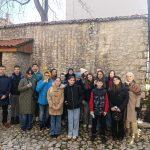Sarajevo and Bosnia and Herzegovina experienced three major wars in the 20th century. These wars lasted a total of twelve years, claiming many innocent lives and causing extensive material and immaterial damage. However, there were also eighty-eight years of peace, often overshadowed by the wars that shook Sarajevo and the region. These eighty-eight years of peace are just part of a centuries-old tradition of living together, which is a pivotal defining characteristic of Sarajevo.
The history of Sarajevo encompasses elements of different people living together in the same space and is evident in various forms of daily cooperation among its residents. Social elements of unity were present, including respect for neighborly relations, holidays, and religious customs. The Museum of Sarajevo, along with other cultural and historical institutions, preserves and revitalizes this tradition through its thematic collections, permanent exhibits, and occasional exhibitions.
Ova zbirka je nastala fuzioniranjem Zbirke radničkog pokreta i NOB-a, koja je prva formirana, i zbirke socijalističke izgradnje, što znači da je ona imala svoj specifičan razvoj. Iako je Muzej grada Sarajeva osnovan 1949. godine, Zbirka radničkog pokreta i NOB-a formirana je tek sredinom pedesetih godina dvadesetog vijeka. Glavni razlog što se tek tada počelo s prikupljanjem predmeta i dokumenata vezanih za radnički pokret i NOB, bilo je postojanje Muzeja revolucije. Naime, neophodno je spomenuti da je u to vrijeme preovladalo mišljenje da Muzej Sarajeva ne treba formirati zbirku i da taj period ne spada u njegov domen rada. Sav materijal koji se odnosi na tu temu već je uveliko bio prikupljen i smješten u zbirkama Muzeja revolucije.
It is to be noted that, initially, the Museum of Sarajevo focused primarily on collecting materials from the city's distant past. It was only later that efforts intensified to gather materials for this collection, recognizing that other local museums addressed similar themes. Despite the difficulties and delays, the Museum rather swiftly succeeded in amassing enough materials, with sometimes having to utilise copies, to establish a permanent exhibition on the workers' movement and National Liberation War (NOB) of Sarajevo. Throughout this process, the Museum acquired valuable and original items and documents, significantly enriching the collection. The Workers' Movement and NOB Collection was thematically divided into two parts: the workers' movement from the late 19th century to 1941 and the NOB- National Liberation War period from 1941 to 1945.
In addition to the Workers' Movement and NOB Collection, the 20th Century Collection also includes the Socialist Construction Collection. This collection documents the life and development of Sarajevo from 1945 to 1990, providing substantial information about the city's history after World War II. Initially, its formation was linked to the NOB Collection, but it became an independent collection in 1979.
Sarajevo has endured numerous hardships throughout its history, but the period of siege and destruction from 1992 to 1995 was undoubtedly the most challenging. During these years, at the end of 20th century, the city suffered immense losses, including civilian casualties and extensive damage to residential buildings, economic facilities, healthcare institutions, schools, universities, and many other public and cultural institutions. The Museum of Sarajevo was not spared, on the top of the devastation of its annexxes, it lost its main building in 1993, which had housed the Museum since 1954. This period also saw the devastation of many of the museum's collections.
During these difficult times, museum employees risked their lives to save as many exhibits as possible. Understandably, not every item could be saved. Consequently, the Workers' Movement and NOB Collection and the Socialist Construction Collection suffered significant damage. During the post-war reconstruction and normalization, these collections were merged into the 20th Century Collection. The items in this collection vary in function, form, and historical value. In addition to various documents, photographs, three-dimensional objects, and publications, the collection includes a complete set of weapons from the NOB period. The exhibits were acquired through purchases, donations from citizens and social organizations, exchanges, and photocopying documents and photographs from other museums and archives.
The cultural and historical value of the 20th Century Collection is immense, as it contributes to the research and understanding of Sarajevo's past with its historical significance and authenticity. The collection comprehensively covers many aspects of life throughout the 20th century. The primary activities of museum experts include researching, collecting, inventorying, studying, classifying, and presenting museum materials. This approach provides a general insight into the historical value and thematic characteristics of the exhibits.
When the museum lost its main building, the collection lost its exhibition space. After completing the collection's revision, it is necessary to restore, restructure, and properly name it according to current museological standards. These efforts will guide the collection's future work, enabling it to provide more comprehensive information about this period in Sarajevo's history. Only when this task is completed, the 20th Century Collection of the Museum of Sarajevo will function as a unique chronicler of the city, enriching the knowledge of Sarajevo's history from its earliest times to the present day.



